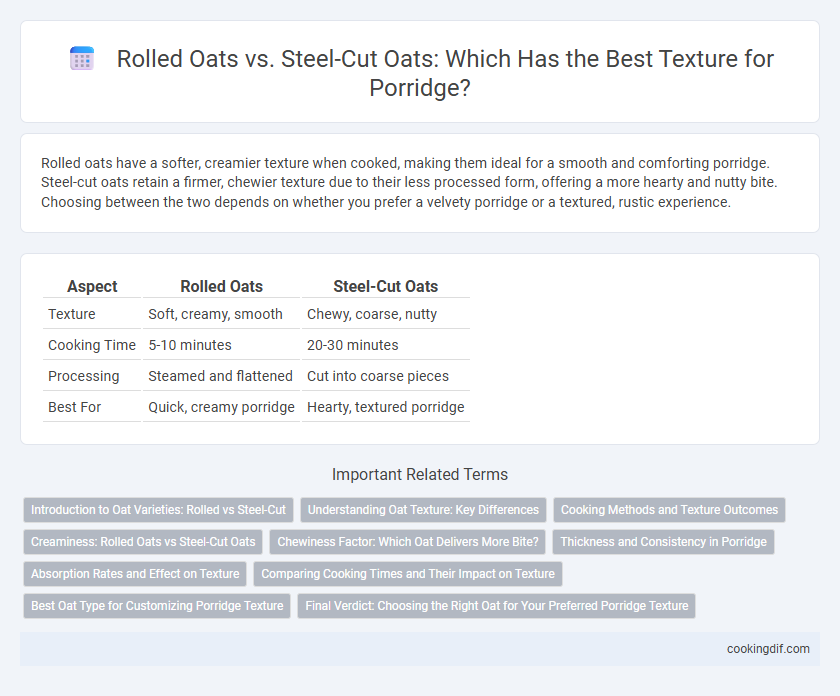Rolled oats have a softer, creamier texture when cooked, making them ideal for a smooth and comforting porridge. Steel-cut oats retain a firmer, chewier texture due to their less processed form, offering a more hearty and nutty bite. Choosing between the two depends on whether you prefer a velvety porridge or a textured, rustic experience.
Table of Comparison
| Aspect | Rolled Oats | Steel-Cut Oats |
|---|---|---|
| Texture | Soft, creamy, smooth | Chewy, coarse, nutty |
| Cooking Time | 5-10 minutes | 20-30 minutes |
| Processing | Steamed and flattened | Cut into coarse pieces |
| Best For | Quick, creamy porridge | Hearty, textured porridge |
Introduction to Oat Varieties: Rolled vs Steel-Cut
Rolled oats have a flat, flake-like texture that softens quickly when cooked, creating creamy porridge ideal for smooth consistency. Steel-cut oats are chopped oat groats with a coarser texture, resulting in a chewier, heartier porridge that retains a nutty bite. Choosing between rolled and steel-cut oats influences the texture and cooking time, tailoring porridge to personal preference.
Understanding Oat Texture: Key Differences
Rolled oats have a softer, creamier texture when cooked due to their flattened, steamed processing method, which allows for quicker water absorption. Steel-cut oats retain a firmer, chewier bite because they are simply chopped whole oat groats without steaming or flattening. Understanding these textural differences helps in choosing the ideal oat variety for your preferred porridge consistency and cooking time.
Cooking Methods and Texture Outcomes
Rolled oats are steamed and then flattened, which allows them to cook faster and produce a creamier, softer porridge texture. Steel-cut oats consist of whole oat groats chopped into pieces, requiring longer cooking times and yielding a chewier, nuttier texture with a more distinct grain bite. The choice between rolled and steel-cut oats directly affects porridge consistency, with rolled oats favoring smoothness while steel-cut oats provide hearty, textured results.
Creaminess: Rolled Oats vs Steel-Cut Oats
Rolled oats create a creamier texture in porridge due to their flattened shape and quicker cooking time, which allows starches to release more readily. Steel-cut oats retain a chewier, coarser texture because they are minimally processed whole oat groats. The higher surface area of rolled oats significantly enhances smoothness and creaminess compared to the heartier bite of steel-cut oats.
Chewiness Factor: Which Oat Delivers More Bite?
Steel-cut oats deliver a significantly chewier texture than rolled oats due to their larger, less processed grain structure. Rolled oats absorb water more quickly, resulting in a softer, creamier porridge, while steel-cut oats retain a firmer bite and nuttier flavor. For those seeking a hearty, chewy porridge, steel-cut oats provide a more substantial mouthfeel compared to the smoother consistency of rolled oats.
Thickness and Consistency in Porridge
Rolled oats produce a smoother, creamier porridge with moderate thickness due to their flattened, steamed grains that absorb water quickly. Steel-cut oats create a thicker, chewier consistency, as their coarse, minimally processed texture retains more bite and requires longer cooking. The choice between rolled and steel-cut oats ultimately influences the porridge's mouthfeel and density, shaping the eating experience.
Absorption Rates and Effect on Texture
Rolled oats absorb water more quickly than steel-cut oats, resulting in a softer, creamier texture ideal for traditional porridge. Steel-cut oats have a lower absorption rate due to their coarse, intact grain structure, producing a chewier, heartier texture with more bite. Understanding these absorption rates helps tailor porridge consistency to personal preference, with rolled oats yielding a smooth finish and steel-cut oats offering substantial texture contrast.
Comparing Cooking Times and Their Impact on Texture
Rolled oats cook in about 5 minutes, producing a creamy, soft texture ideal for smooth porridge, while steel-cut oats require 20-30 minutes and yield a chewier, nuttier consistency with a firmer bite. The longer cooking time of steel-cut oats allows them to retain more structure, resulting in a heartier, less mushy porridge compared to the quicker, more delicate rolled oats. Texture preference often guides the choice, with rolled oats favored for softness and steel-cut oats for a more substantial chew.
Best Oat Type for Customizing Porridge Texture
Rolled oats offer a soft, creamy texture that absorbs liquid quickly, making them ideal for smooth, easy-to-customize porridge. Steel-cut oats retain a chewier, nuttier consistency due to their less processed form, perfect for a hearty, textured porridge experience. Choosing between rolled and steel-cut oats allows precise control over porridge texture, catering to preferences from velvety to robust.
Final Verdict: Choosing the Right Oat for Your Preferred Porridge Texture
Rolled oats create a creamy and smooth porridge texture, ideal for those who prefer a soft and easily digestible breakfast. Steel-cut oats offer a chewier, nuttier texture with a heartier bite, perfect for individuals seeking a more substantial and textured porridge. The right oat choice depends on personal preference: rolled oats suit quick-cooking, creamy dishes, while steel-cut oats provide a robust, textured experience.
Rolled oats vs steel-cut oats for texture Infographic

 cookingdif.com
cookingdif.com